|
593
OVER THE NARROWEST NARROW GAUGE.
Harper's Monthly—1875
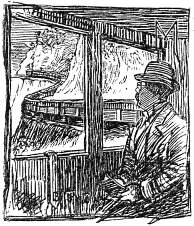 MADOC sailed
out and discovered America, rather behind the Norsemen, but some
hundreds of years before Columbus had an opportunity to do so.
He penetrated to southern Missouri, as stated by Southey. There
are Welshmen who believe that his descendants are still to be
traced, speaking a purer Welsh than remains in the mother country. MADOC sailed
out and discovered America, rather behind the Norsemen, but some
hundreds of years before Columbus had an opportunity to do so.
He penetrated to southern Missouri, as stated by Southey. There
are Welshmen who believe that his descendants are still to be
traced, speaking a purer Welsh than remains in the mother country.
By way of returning the compliment, an occasional American
drops down and discovers the little port of North Wales from which
Madoc sailed. More likely than not he is an engineer from Virginia,
the Rio Grande, or Venezuela, come to see its principal curiosity
for practical purposes at home. The European visitors comprise
a formidable list of celebrities. The Duke of Sutherland came
down in 1870, piloting an imperial Russian commission with attaches
from all the continental powers and the East Indian government.
"I wish I had known of it before," said he; "it
would have saved me a million dollars in my estates."
This curiosity is the line, less than fourteen miles in length,
from Port Madoc to the Festiniog slate district, known as the
Festiniog Railway. It is nominally two feet wide, but really one
foot eleven and a half inches, and enjoys the distinction of being
both the oldest and the narrowest narrow gauge in the world. It
was the war cry—and the basis, in fact—of the second
of the violent modern controversies known as the battles of the
gauges. The first of these, it will be remembered, was between
the gauges of seven feet and upward, supported by the noted Isambard
Kingdom Brunell, and the standard gauge of four feet eight and
a half inches. Brunell proposed to attain unheard of speed, retaining
stability as well, with eleven-feet tracks, ten-feet driving-wheels
for locomotives, and carriages hung between, instead of upon,
the wheels. I have conversed with a pupil of his, now a distinguished
supporter of the extremely opposite views, who shared his experiments,
and rode with him at close to eighty miles an hour, after eight-feet
driving-wheels, on his Great Western road. He mentions a violent
and dangerous lateral jar in the suspended carriages as the cause
of their abandonment. The Great Western itself, as late as 1874,—the
Waterloo, it might be called, of the first struggle,—was
relaid to the standard gauge, all comfort and profit in the use
of it having been destroyed by the necessity of transhipment at
points of contact with others.
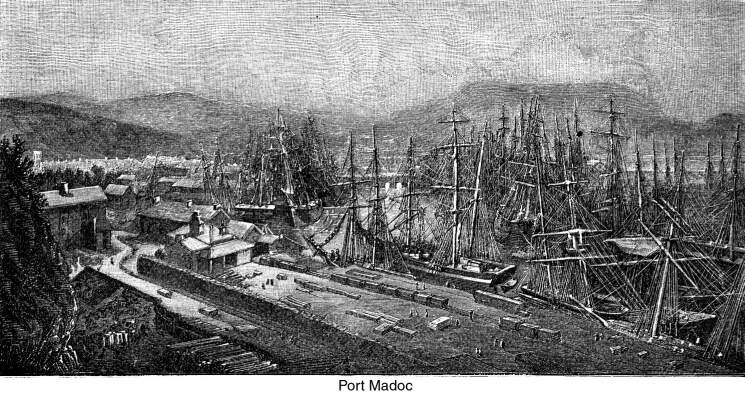
The second battle, the bombardments
594
and hand-to-hand conflicts of which are still far from having
come to an end, was begun by the favorable report of a government
inspector on the opening of the Festiniog Rallway to passengers
in 1865. It was accelerated by other reports still more favorable
on the placing on the track of a peculiarly constructed engine,
the Fairlie, demanded by its increasing business in 1869. In the
meantime a way of looking at railways from the point of view of
their profits more than for striking feats had set in. They had
not paid as was expected of them. The idea was broached and eagerly
caught at, from the new information at hand, that they were extravagantly
large, instead of stingily small, according to the reproach of
Brunell.
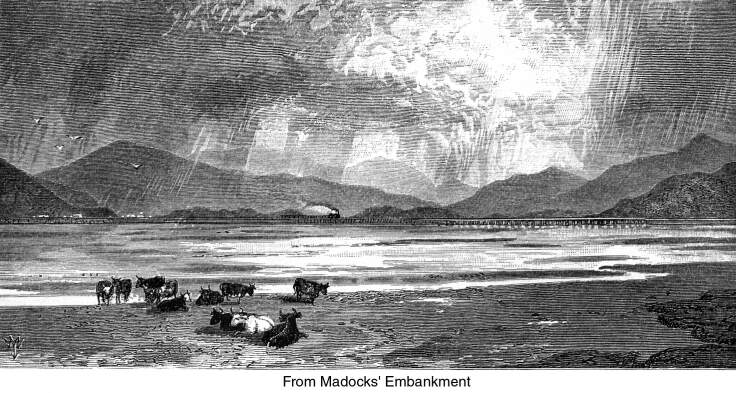
The Festiniog Railway has lost its exclusive prominence as
an example, and is no longer the Mecca it was, now that some twelve
thousand miles of narrow gauges have been laid down in other parts
of the world. Most of them are among ourselves, however,—there
are estimated, eight thousand miles for the United States and
Canada,—and the circumstance adds more than it detracts from
the interest to the transatlantic visitor, who may promise himself
entertainment in seeing what this fourteen miles of road, parent
of twelve thousand, is actually like. It was the Christmas season
of the last year when I came up to it, by roundabout ways, from
the yellow gloom of London. The Severn was frozen for skating
in Shropshire. In the Welsh country the oldest inhabitants were
telling each other that it was a time quite remarkable in their
experience.
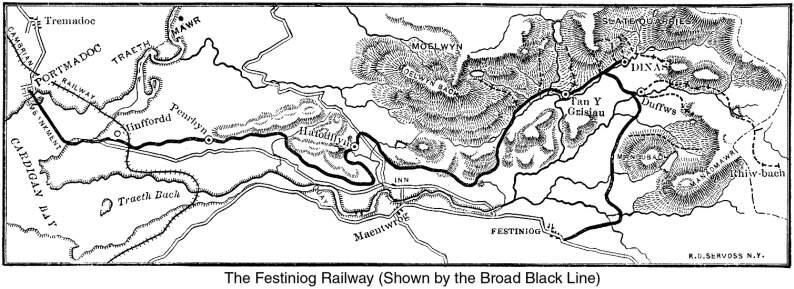
Nothing remains of Prince Madoc. It is not even certain that
it is his name Port Madoc bears, since it was founded early in
the present century by one William Madocks, who may only have
intended to commemorate himself. He expended half a million dollars
in building an embankment a mile long across an estuary of the
sea which formerly ran back Dearly to the foot of Snowdon, and
595
thus redeemed seven thousand acres of land, which he left,
a fine property, to his creditors, having ruined himself in the
undertaking. The Snowdon range is the center of the district.
It is not stupendous, as mountains go, but the stem dark color
and the volcanic nature of the upheaval give an impressiveness
beyond the size.
Port Madoc is a town of four thousand inhabitants. It has a
notably staid and respectable air. There is a long principal street,
of heavy two-story stone houses, broken by an ambitious market
and a station for the district police. The trading in the neat
small shops is entirely in the hands of Evanses, Lloyds, Griffiths,
Owen and John Joneses. The houses climb a steep hill on one hand,
and stretch out to the flat on the other. There are monotonous
rows of them, each with a pretty bay-window, not unlike the -dwellings
of Washington clerks, except that they are not of brick. No sounds
of revelry come out of the Quarrymen's Arms. "Temperance"
signs prevail, and chapels are so numerous as to be a special
feature. They are chiefly of the dissenting sects, the Church
of England having never recovered the hold upon the people which
it early lost by a neglect of the national language.
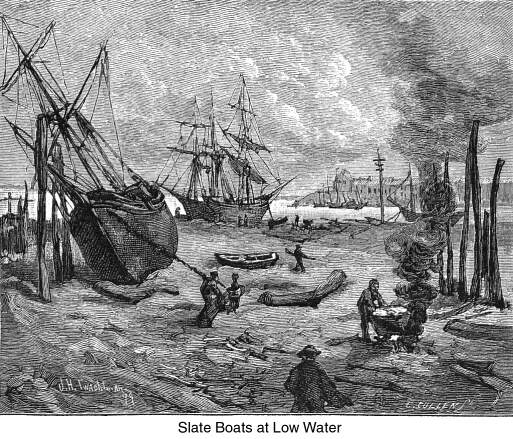
There is an equal seriousness in the port, among the neatly
piled palisades of slates awaiting removal. The waterside inns
are temperance inns, too. One would say they were kept by the
deacons of the chapels. A jolly tar is never seen by any chance
staggering under other than his legitimate burdens. The slate
wagons, numerously scattered in the yards, are small vans of iron
lattice work, standing but eighteen inches above the track, carrying
a couple of tons, and easily pushed about by hand. The line is
seven hundred feet higher at one end than at the other, having
an average gradient of 1 in 92, and a maximum of 1 in 69, and
they come down mainly by gravity-by their own impudence, I have
heard it called.
The shipping is of sufficient extent to make an impressive
tangle of mast. From an elevated point one would say that buildings,
ships, quays, and the black little island hills in William Madocks'
redeemed land—Madoc is said to have sailed from one of them—had
drifted in together, and were held in an eddy, under a protecting
angle of the shore.
The first and only level mile of the railroad crosses Madocks'
embankment. There is a vast, bare stretch of sands from it when
the tide is out, with a real charm in its character of simple
desolation. From another point the black slate boats lie stranded,
with Mount Snowdon showing through their rigging. When the storms
beat in, lines of Ossian come naturally to one, on these high
northern coasts so near to where they bad their origin. The heroes
rise like the break of a blue rolling wave, and the ghost of Crugal
retires with the darkened moon in the whistling blast.
The Festiniog road was founded by the
596
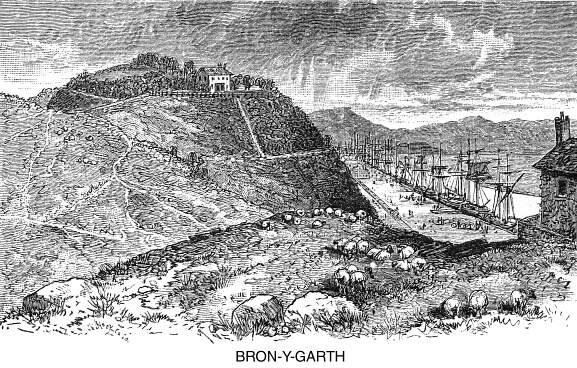
Spooner family, and the third generation is now taking part
in the management of it. Their attractive, ivy-clad homestead,
Bron-y-garth, hangs on a picturesque hill above it, where all
its goings-out and comings-in are under the eye. It is a family
of quite the traditional British hardihood, if the accounts be
true. Its list of accidents and hairbreadth 'scapes is too long
to set down here; but the small road, innocent enough for others
and without a case of fatal damage in its annals, has certainly
subjected its responsible heads to severe proofs. The senior member
is a hale, dignified gentleman of sixty. His son, a young man
of energetic and companionable traits, my guide in the subsequent
explorations, assures me that he is not beyond the ability to
turn "cart-wheels" yet with the agility of youth. From
the Spooners I beard the story of the road at first hand, with
something of the romance of Madocks and the antiquities of the
neighborhood. James Spooner came into the country from Yorkshire
on a pleasure excursion. He hunted rabbits over most of the site
where the town and docks now are. There he fell in with ordnance
surveyors, was pleased with the business, became an engineer,
and returned to assist Mr. Madocks in his projects. The slate
quarries in the mountains were being tediously and expensively
served by boats down the river Dwyryd (Doorid). He secured in
1832 the laying of a horse tram-road to them. There was a brilliancy
in these improvements at that time that caused people in the early
part of the century to congratulate themselves on their progress
and look forward to extraordinary things. One horse on the rails
could do the work of forty.
James Spooner advanced to the idea of steam on his track, but
was unable to realize it, and left it as a legacy to his son.
The difficulty was to find locomotives that could be guaranteed
for the peculiar conditions of narrowness and curvature. The son
succeeded in carrying out the bold conception in 1863, putting
on tank engines, of the type of the "Little Giant" and
"Welsh Pony." The shoulder easily overtops these small
locomotives as they stand on the track. Their driving-wheels are
but two feet in diameter. Their cylinders are a trifle over eight
inches, with a twelve-inch stroke. Instead of the thirty, forty-five,
and even seventy tons of standard gauge locomotives, they weigh,
the first seven and a half, the other ten at most.
No change was made in the track, except to replace the original
sixteen with thirty-pound rails. A two-foot gauge it had been,
winding around all the convolutions of the hills, and a two-foot
gauge it remained. After a couple of years more development of
trade and population, there was a crying demand that it should
carry passengers. This was against the law. The inspector who
was to give it celebrity came up, saw what it could do, and made
his report. The permit for passengers was secured, but with a
restriction of speed to twelve miles an hour.
As business grew, continually increasing loads were piled on
carriages and capacities were thus developed that had not been
dreamed of. Toward 1870 traffic had so outgrown the limited provision,
that it seemed necessary to double the track. As a possible alternative,
experiments were first tried with the Fairlie locomotive. It proved
597
to furnish such a satisfactory increase of power that the idea
was abandoned and has never since been renewed. The "Little
Giant's" prestige was blotted out by a twenty-ton "Little
Wonder." The next step demanded in this gradual progress
upward was a stronger support for the new crushing weights. The
weight of the rails was made nearly forty-nine pounds to the yard,
and even these are now being replaced with steel of fifty. The
restriction as to speed was withdrawn, the employees were handsomely
uniformed, and the whole became and remains as like as possible
in miniature to the ordinary European railway.
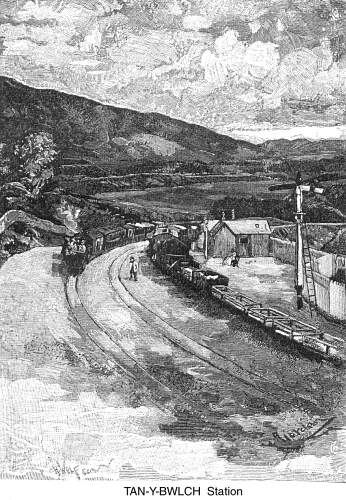 The small wooden
station at the end of Madocks' embankment has hardly more than
the look of a sentry-box. One rather expects to find the tickets
diminished in proportion, and the company's servants stunted in
their growth. But the former are of the usual size, and porters,
guards, and brakemen bustle about with as important an air as
if they had never been out of the service of Isambard Kingdom
Brunell. The small wooden
station at the end of Madocks' embankment has hardly more than
the look of a sentry-box. One rather expects to find the tickets
diminished in proportion, and the company's servants stunted in
their growth. But the former are of the usual size, and porters,
guards, and brakemen bustle about with as important an air as
if they had never been out of the service of Isambard Kingdom
Brunell.
All the steps of the historical development are read in the
varied patterns of the rolling stock. The earliest is the quarrymen's
car. It is a mere rude box, eight feet by six, by four and a half,
perhaps, painted dark red, and provided with two openings for
doors. The next period is typified by a car for six persons, with
the usual door and flanking windows in each side. It has a palanquin
or sedan-chair effect. It might be considered the germ or a single
cell of the foreign carriage, which consists of a number of compartments
united in the same structure for the different classes. There
are others of two cells. There is a variety with longitudinal
seats. Others again are open, with stout leather aprons for protection
from the weather.
The latest model is a handsomely finished car, with the peculiarity
of being very much larger instead of smaller than its broad gauge
contemporaries. It is thirty-seven feet long, has seven compartments,
and carries fifty persons. The best Cambrian or North-western
carriage on the journey hither had but four, with room for thirty-two.
This latest Festiniog car rests on two pivoted trucks or "bogies"
of four wheels each, while those of the regular foreign pattern
run stiffly on four fixed single wheels, after the manner of our
street-cars. There is a disposition to make a good deal of the
bogies as a striking original feature, though from the first days
of railroading they have been part of the American system to the
entire exclusion of the other. A few are lately being introduced
on the Midland and South-western railways of England.
Among the rest, a peculiar conveyance like the section of a
boat on wheels, inscribed: Ni l'un ni l'autre, known as
"the Boat," is for the use of the manager and his family.
The goods wagons weigh eighteen hundred pounds, and carry two
and a half tons. A pair of timber wagons coupled, weighing thirteen
hundred each, carries nine tons. For stability, all the floors
are kept as near the ground as possible. In the passenger cars,—whose
wheels run inside, and for oiling are reached from doors in the
seats,—
598
they are but a single step above the track, a feature which
allows platforms to be dispensed with at the stations.
The transportation rates are quite tolerable: for a passenger,
slightly less than three and a half cents a mile, first class;
two and a tenth cents, second class; for a ton of goods, five
and a half cents. On field days, before assembled magnates, the
"Welsh Pony" has drawn up trains of nearly seventy-four
tons, and the "Little Wonder" of two hundred and six.
On any day the former is to be seen going out on its ordinary
work with between fifty and sixty tons, and the latter with nearly
a hundred and thirty.
Enthusiastic observers of the performances of the Fairlie engine
here have staked their reputation on being able with them to run
the whole traffic of the London and North-western road on a gauge
not to exceed two feet and a half. Fairlie, the inventor, an indefatigable
controversialist and undoubtedly the most strenuous narrow gauge
advocate in the world, declares that without it, narrow gauge,
per se, is not worth a straw. Singularly enough, it is
very moderately used on the American narrow gauges, which content
themselves with the "Consolidation," "Mogul,"
and more ordinary patterns.
As the slate wagons go up empty and come down with so little
effort, the trains are often of great length. They are frequently
a thousand feet, and sometimes a full quarter of a mile. The interminable
line of small units, as flexibly jointed as a trailing chain,
moves around the curved route at from twelve to fifteen miles
an hour. It is sometimes on three or four curves at once.
Passenger trains have been run as fast as thirty and even forty
miles an hour. The traffic for the year ending with June, 1878,
reached 233,000 passengers, and 165,000 tons of freight, returning
an income of $133,000. Its rate of traffic even six years ago
was fifteen times greater than that of the three existing Indian
railways, and was made an argument to show that for the future
they should be narrow gauge.

The track over which this is done demands particular attention
before any inferences can be drawn for use elsewhere. Here is
something, too, very different from what is said abroad to be
the American plan of "building cheap and running dear."
It is of this section:
The rail, as has been said, is of nearly forty-nine pounds
weight, and will shortly be fifty of steel. The American narrow
gauge rail is from thirty to thirty-five pounds, and that of our
standard gauge, fifty-six. The larch cross-sleepers, but two feet
apart at the joints, are framed to longitudinal sills as shown.
The fish-plate grips the lower flange, as well as the web of the
rail. The whole way is carefully drained by depressions under
the track, at regular intervals. Examination shows the ballast
to be without a crack of subsidence or shrinkage. One is not in
the least inclined to dispute the account which has pronounced
it "a perfect road-bed."
II.
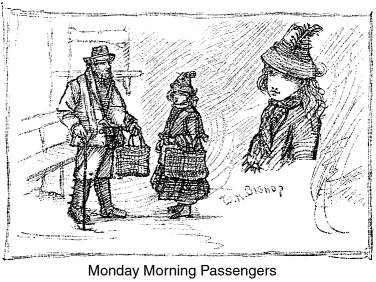
WE had agreed, in order to witness one of the more unusual
phases of the life of the road, to go by the quarrymen's train.
It starts only once a week, at six o'clock Monday morning. In
part through lack of accommodations above, and partly to have
access, in case of need, to work elsewhere, large numbers of the
men keep their homes and families below, and return to them on
Saturday afternoons. It was naturally much before daylight, at
this hour of a midwinter morning. Snow-flakes fell thickly at
intervals. The quarrymen came trooping out of the silent streets
with their kits of supplies in canvas bags knotted across their
shoulders. They stamped the snow off their heavy boots in the
station, and talked softly together in their strange tongue.
599
Among them—the one touch of brighter sentiment in the
scene—a rugged man, stiff in the joints from toil, had beside
him a pretty child, a girl of ten, who carried in a satchel a
part of his provisions. She was shabbily dressed, as became a
quarryman's daughter; the small face was rosy with the storm,
and the unkempt blonde hair had a genuine interest even apart
from her circumstances. His only reply to compliments was the
common dim Saesnach (no English) impassively spoken.
The engine at the head of the long train of red-painted boxes
slipped on the icy tracks and did not easily get under way. While
it fumed and shrieked in the rage of ineffectual efforts, telegrams
came down the line countermanding the train. It would be useless
to proceed till the way was cleared above. The next in regular
order was also stopped. In the middle of the forenoon, a single
engine drew up in charge of Williams, head of the machine-shops,
and the most trusted mechanic on the line. We jumped up beside
him and found ourselves embarked for the journey on the Fairlie
engine, "Little Wonder," which justified the accounts
of the easy gliding motion and absence of oscillation attributed
to it, as we flew out over the embankment.
This engine has an odd, aggressive-looking build. It is really
two locomotives framed together. With double boilers, smoke-stacks
and pairs of cylinders, ready to start either way, one end is
as much the front as the other. It seems to defy gods and men
to catch it napping. It bears lightly on the track by having all
wheels drivingwheels, and the weight distributed equally on them.
The bogie or pivoted truck is here again a leading feature. The
rolling gear is simply one of these at each end. Its difference
from two locomotives coupled to work together is in this, that,
in turning a curve, the stiff frame acts as the chord of the arc.
The leading bogie is securely held to the track by the other.
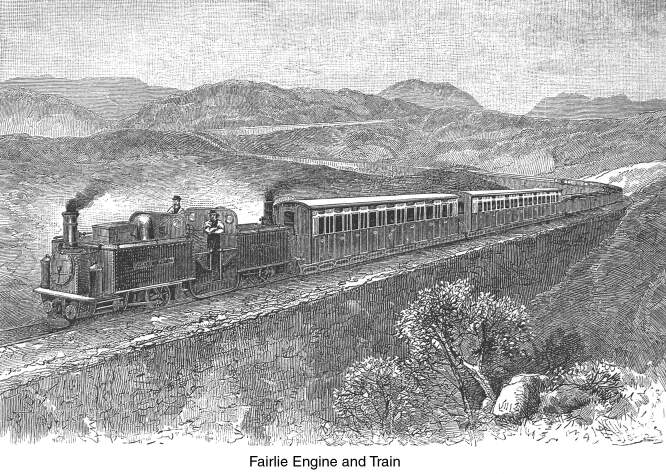
The first stoppage is at the shops at the other end of the
embankment. They are of some size, and well furnished with what
is necessary for building and repairs. Ingenious American screw-cutters
are among the tools. One is called upon to note that the smallness
of the parts to be dealt with, and of lifting tackle and apparatus
in general, is one of the economies of the plan. At the shops
we take up a burly individual walking in a leisurely way on the
track. This is the "strongest man on the line." "It
may be convenient to have him along farther up," says the
young superintendent, as the Samson stows himself comfortably,
and lights his pipe, on the buffer beam.
At Minffordd, the junction with the, Cambrian line, is a stone
station,—the only one,
600
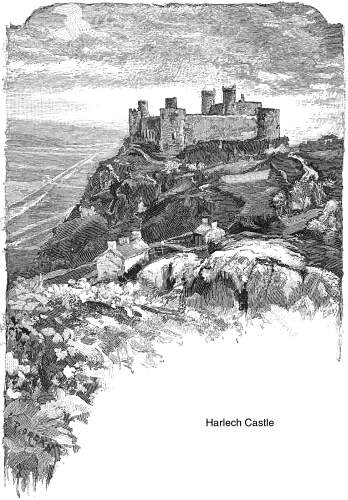 like a modest
porter's lodge. Neat transhipment arrangements here claim attention.
The disparity of sizes is glaringly forced into notice. The driving-wheels
of the forty-ton Cambrian locomotive are not far short of the
top of the smoke-stack of the other. Its goods truck is three
times the length and twice the height of the smaller one. The
two are brought side by side to a level, the smaller trucks being
run upon raised platforms. Mr. Spooner estimates the damage of
his break of gauge at not more than the three pence to sixpence
a ton charged on the 25,000 tons interchanged at this point. like a modest
porter's lodge. Neat transhipment arrangements here claim attention.
The disparity of sizes is glaringly forced into notice. The driving-wheels
of the forty-ton Cambrian locomotive are not far short of the
top of the smoke-stack of the other. Its goods truck is three
times the length and twice the height of the smaller one. The
two are brought side by side to a level, the smaller trucks being
run upon raised platforms. Mr. Spooner estimates the damage of
his break of gauge at not more than the three pence to sixpence
a ton charged on the 25,000 tons interchanged at this point.
There would be a much greater disparity of sizes were there
parallel systems of construction. The broad gauge takes its loads
more like an elephant its castle, while the widely overhanging
narrow gauge is like a donkey with its paniers. The freight cars
of the latter are more than twice, and its passenger coaches more
than three times, the width of its track.
"With a proportion like ours," says my companion
and guide, "the standard gauge carriages would be fifteen
feet wide instead of eight or nine. They cannot adopt it. It would
crush their tracks in no time. If that were not reason enough,
it would destroy the necessary mid-space between tracks and require
the alteration of all tunnels and standing fixtures, adapted to
the present width."
There is another reason, it occurs to one to reply, the added
liability to destruction of the cars themselves. The tendency
is constantly to make them stronger and heavier, even as they
now are. It is not a matter of theory, but of policy, derived
from experience of the customary wear and tear. It is estimated
that the weight of rolling stock, in America, has increased from
fifty to one hundred per cent. in the last twenty years.
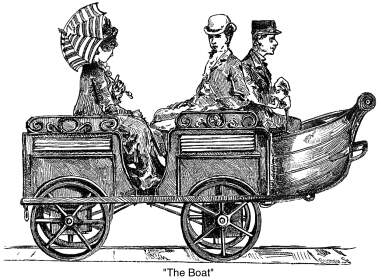 "Why
don't they take a gauge where they can get all out of themselves
they are worth, then?" he says, being naturally an enthusiast
for the system whose working be has witnessed to such advantage. "Why
don't they take a gauge where they can get all out of themselves
they are worth, then?" he says, being naturally an enthusiast
for the system whose working be has witnessed to such advantage.
601
The delicate question of the ratio of dead to paying weight
is involved in this, and indeed the whole perplexed question.
Our talk becomes, in the intervals of the failure of special objects
of attention along the line, a sort of narrow gauge symposium.
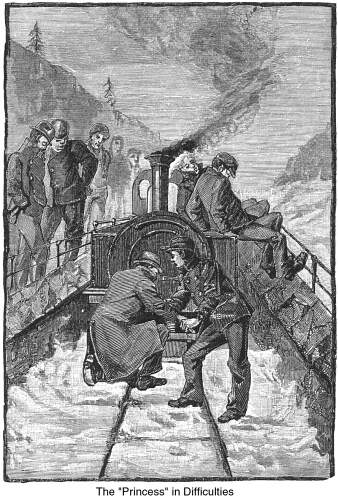 There surely
are not many controversies in which two positions oppose each
other with such an apparent completeness. If more cuttings and
tunnels and heavier rolling stock are adduced against the broad
gauge, more miles of track, sheds and sidings, longer trains more
difficult to pull, and diminished speed are retorted on the narrow.
Mr. G. B. Bruce, in the noted deliberations for the benefit of
the East Indies, estimates the saving by use of the narrow at
200 pounds per mile, General Strachey at 2,000 pounds, while Mr.
R. Price Williams (all are authorities of the highest consideration)
believes it will be an actual extra expense of 300 pounds per
mile. In Norway a broad gauge road is being turned into a narrow
because it does not pay. In Sweden a narrow is being changed into
a broad for the same reason. The evidence in the vital matter
of break of gauge has equal range. It varies from the petition
of the people of South Wales, to the Great-western, setting forth
that break of gauge is a curse, and prohibitory of their principal
traffic, to the opinion of a superintendent of the Erie road,
who declares it a positive benefit, as saving the damage to empty
returned cars. There surely
are not many controversies in which two positions oppose each
other with such an apparent completeness. If more cuttings and
tunnels and heavier rolling stock are adduced against the broad
gauge, more miles of track, sheds and sidings, longer trains more
difficult to pull, and diminished speed are retorted on the narrow.
Mr. G. B. Bruce, in the noted deliberations for the benefit of
the East Indies, estimates the saving by use of the narrow at
200 pounds per mile, General Strachey at 2,000 pounds, while Mr.
R. Price Williams (all are authorities of the highest consideration)
believes it will be an actual extra expense of 300 pounds per
mile. In Norway a broad gauge road is being turned into a narrow
because it does not pay. In Sweden a narrow is being changed into
a broad for the same reason. The evidence in the vital matter
of break of gauge has equal range. It varies from the petition
of the people of South Wales, to the Great-western, setting forth
that break of gauge is a curse, and prohibitory of their principal
traffic, to the opinion of a superintendent of the Erie road,
who declares it a positive benefit, as saving the damage to empty
returned cars.
The solution is not facilitated as much as might be thought
by the increase of examples. The narrow gauges are still on their
trial. It is certain that any railroad is better than none, but
perhaps time enough has not elapsed for the oldest of them to
allow it to be determined that another than the policy pursued
might not have been better. The cynical broad gauge advocate is
not afraid to account for their late multiplication by asserting
that speculators obtain money for their projects by the specious
new arguments which could not be got in the regular way. He refuses
credence to the brilliant financial showings of roads whose bonds
are still in the market.
Away from the bustle of its business at the stations, the small
single track assumes its essential character. Let it be imagined
that it is one-third narrower than the miniature railway at the
Centennial, narrower than the track-ways on which casks are rolled
in breweries. The two dark lines are drawn on the snow between
low walls, like the trace of a single sled down a country lane.
Larch, oak and yew are scattered in the estates, and sometimes
lovely holly trees close by the track relieve their scarlet berries
against their glossy dark leaves.
A wide view opens from the top of Penrhyn point. Backward it
reaches to two ancient castles, Harlech and Criccieth, flanking
the stretch of Cardigan bay. Any Welsh pianist will play you a
stirring martial air—the "March of the Men of Harlech"—from
the history of the farther one, whose ruin is particularly striking.
Forward it embraces the valley whose windings the railway follows.
It has vestiges of a charming rural beauty even now, when the
climbing trees are but a gray and brownish fringe, and the river
down in the bottom
602
is as black and metallic as a strip of polished iron.
The road is scarped into the hill-sides, and follows every
convolution of them like a bridle-path. It has been compared to
a random juxtaposition of letters S. A long train appears to be
playing the boy's game of "snap the whip.'' There are places
from which it moves to all points of the compass at once. The
winding plan, besides saving cuttings, results in easy gradients.
But there are obstacles which the most circumlocutory of narrow
gauges cannot dodge. If they be ravines it crosses them on dry
stone masonry embankments. One is sixty feet high, and from its
slenderness—it is but ten feet wide at the top—it seems
more. If they be spurs of the mountain, it has of course to cut
through them. It cuts so narrowly that the person must be carefully
kept within the engine cab for fear of collision. The margin is
but a few inches. To enter the eight-feet tunnels is like plunging
into a cellar door. There are two of these, one of 73, the other
of 60 yards, neither lined. A dismal crackling is heard as we
traverse the large one; it seems that fragments of the roof are
falling; On coming to the light they prove to be icicles.
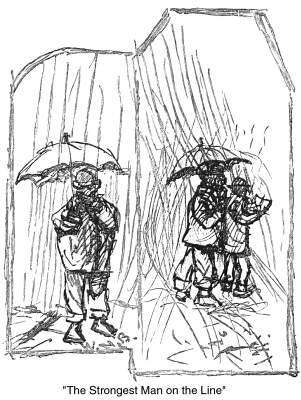 The sharpest
of the interminable curves is of but 116 feet radius. It turns
a headland known as Tyler's Cutting. To dash around it at speed
with snow in one's face, and the engine careening over on account
of the super-elevation of three inches in the outer rail, is a
highly spirited experience. The sharpest
of the interminable curves is of but 116 feet radius. It turns
a headland known as Tyler's Cutting. To dash around it at speed
with snow in one's face, and the engine careening over on account
of the super-elevation of three inches in the outer rail, is a
highly spirited experience.
At Tan-y-gresiau one of the smaller pattern of engines, the
"Princess," was off the track. The snow was not of the
depth we had been led to expect, nowhere more than two or three
inches; but the wet clinging quality of it, and the deficiency
of the line in other snow-plows than old brooms tied to the engine's
head, made it embarrassing. The "Princess's" head was
being lifted with small jack-screws, while a number of men mounted
on the side, with their backs braced against the boiler, pushed
against the wall, just as one might try to help a road wagon out
of a rut. Here was an opening for the Strongest Man on the Line.
I observed that the method of employing his herculean powers which
seemed to him the most telling was the holding of an umbrella
over the artist while a hasty sketch of the scene was made.
The accident gave rise to reminiscences, when we were again
under way. None of them were tragic. Williams recollected a case
of collision in which a horse in one train was pitched exactly
into the place of one in the other, while the latter was thrown
many yards into a field.
A slight whistle which must have meant incredulity proceeded
from somewhere on the engine.
"It's thrue for me as I'm a living Welshman," said
Williams.
Near the upper villages children were running in procession,
tracing letters in the snow. The people who came to the doors
to look out at us were of a well-conditioned aspect. The dwellings
are of coarse masonry but well glazed, the wood-work painted,
sometimes a muslin curtain and often a geranium pot in the windows.
There is no brilliancy about the slate, the sober treasure
of the region, but it keeps times tolerably good and the population
well at home with sufficient employment. Still there are adventurous
spirits, and young people from here, as elsewhere, make their
way up to London. They do well in trade in virtue of a natural
thrift. They learn English without the unpleasant cockney accent.
The best people, indeed, speak it quite in the best American manner.
On the other hand, possibly sixty per cent.
603
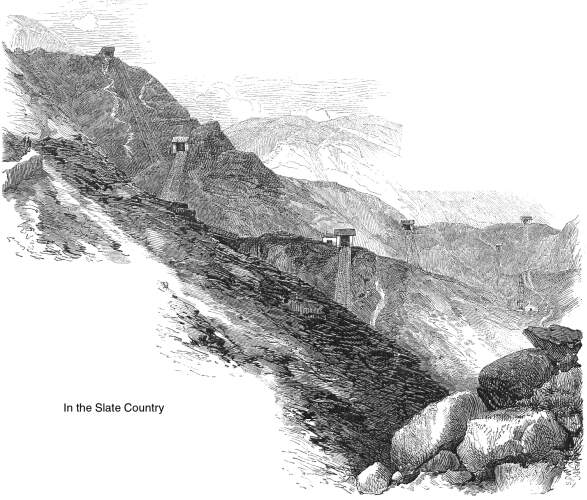 of the lower
orders do not speak it at all. It is one of the surprises of the
visit to find the ancient Gaelic speech, substantially what it
was before the Roman conquest, enjoying in this long-time principality
of England, fully the vogue of Flemish in Belgium. It is a speech
full of alliterations and permutations, straining after impossible
refinements. The pains might be bestowed in part, an observer
thinks, on the original structure. If you wished to cry murder,
you would have to compass Hai wchw! Avaunt is ffwrd,
which has the air of an explosion after holding the breath to
the point of suffocation. It is a language in which the too much
offsets the too little. There is no present tense, and no distinction
of sex by genders. On the other hand there are four different
ways of saying I, graduated according to emphasis. One
of them is impossible in English, but the others maybe translated:
I, I also, I also indeed. Some peculiarities of the resulting
dialect are thus exhibited in a late comic paper: of the lower
orders do not speak it at all. It is one of the surprises of the
visit to find the ancient Gaelic speech, substantially what it
was before the Roman conquest, enjoying in this long-time principality
of England, fully the vogue of Flemish in Belgium. It is a speech
full of alliterations and permutations, straining after impossible
refinements. The pains might be bestowed in part, an observer
thinks, on the original structure. If you wished to cry murder,
you would have to compass Hai wchw! Avaunt is ffwrd,
which has the air of an explosion after holding the breath to
the point of suffocation. It is a language in which the too much
offsets the too little. There is no present tense, and no distinction
of sex by genders. On the other hand there are four different
ways of saying I, graduated according to emphasis. One
of them is impossible in English, but the others maybe translated:
I, I also, I also indeed. Some peculiarities of the resulting
dialect are thus exhibited in a late comic paper:
OWEN-That will pe the coot whuskey, David.
DAVID—She is the pest I never tasted.
OWEN—So did I too, also, never no more.
The heart of the slate country is treeless and desolate, like
the top of an Alpine pass. The imaginative discover fantastic
resemblances in the jagged mountain outlines. From a point on
the road to Snowdon the profile of Wellington is thought to be
made out, and from another, the head of Pitt.
The quarries are vast abysses, gloomy as the pictures in Dante's
Inferno. Slate is everywhere. It strews the slopes with debris
turning the light with slight bluish reflections; is set into
the tops of walls instead of broken glass; and stands in irregular
slabs like tomb-stones, for fences around outlying houses.
There are inclined planes striped on the slopes, rising to successive
levels. At the top of each a small "drum-house" contains
the drum, by means of which with its wire rope, the full slate
wagons are lowered, pulling up the empty ones. Black water-wheels
are seen turning slate-trimming machinery.
The homes of the quarrymen are for the most part in barrack-like
structures on the heights. They are little given to revelry, and
there is little in the villages to attract them down if they were.
We passed the yellow van of a traveling show at one point, lying
deserted in a field, melancholy as a grasshopper in winter. Both
horses and proprietor had turned out to work in the quarries.
Tired with the labors of the day in the shafts, or in the shops
where the slates are split on the bare damp ground, they sit around
the fire, telling one another stories (possibly of the mysterious
knockers, which haunt mines and point out the way to hidden treasures),
and await the coming of the welcome Saturday afternoon.
604
Dinas, the upper terminus of the road, is an inconsiderable
hamlet. The real metropolis is Duffws (Duffoos), a place of perhaps
three thousand people. Festiniog, considerably smaller, is four
miles further, but is reached by a branch which follows the hills
on the other side, back toward Port Madoc. It has a charming view
over the vale of Maentwrog, besides Roman remains and picturesque
waterfalls of its own in the Cynfael. A hundred years ago, when
it was more secluded, a traveling lord, who is there much quoted,
praised its salubrity, and said that with the woman he loved,
the friend of his heart, and a good library be could spend a life-time
there. It is not extreme praise, since it would not be difficult
to get on tolerably under the circumstances in many another place
as well; and it deserves more. In all the settlements new buildings
are going up; there are comfortable goods in the shops; the same
characteristics prevail as below, including the frequent chapels.
The down journey is made with only steam enough to keep the
cylinders in good condition. There is less novelty now, and it
is a time for summing up. The small railroad pays, it is gratifying
to know, a dividend of seven per cent. on its present, and of
nearly seventeen on its original, capital, which has been increased
by earnings from 36,000 pounds to 86,000 pounds. It meets all
the demands upon it without trains before eight or after six o'clock,
or on Sundays. The propriety of this statement as a proof of extraordinary
capacities in small widths of track, is unquestionable.
Still—so one's reflections run, if they do not appear
so openly in the symposium—it has the regulation of its own
tolls, and is without a particle of competition. It runs safely
with light carriages, but on a magnificently expensive roadbed,
without pressing necessity for speed, and without the battering
of its property by a system of exchanges. It has sharp curves,
but not a monopoly of them, and not the sharpest, while its shortest
radius is 116 feet. The New York elevated roads, of standard gauge,
are running their innumerable daily trains over four curves of
ninety feet radius and one even of forty-five.
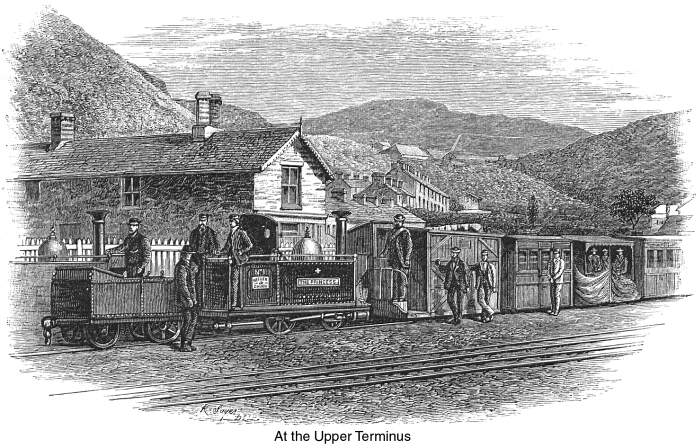
Profitable as it is, too, the last three semiannual reports
show a ratio of from sixty-three to sixty-nine per cent. of receipts
devoted to working expenses, while forty-eight is looked upon
as fairly liberal for English roads. There seems almost margin
enough in the large returns, too, to have paid for a full gauge
road. It has never been needed, to be sure; but at the present
time it might be rather useful to have. The competition from roads
of the standard gauge, which must be expected sooner or later
by every narrow gauge road not placed in the most exceptional
circumstances, appears at hand. Both the Northwestern and the
Great Western are coming in with branches to its upper terminus.
It
605
looks as though the slates must turn and go the other way in
good part, leaving the neat platforms and tipping tables, at Minffordd
at least, with little to do.
On the whole, it is difficult to accept it as an argument for
anything but itself. A novel idea in railroading has extreme difficulties
in its way. If it cannot subvert the existing system or isolate
itself forever, it must suffer at every point of contact. In the
United States, it is possible that the narrow gauge owes its propagation
to the wide-spread railroad embarrassments since the panic of
1873, more than to the convincing nature of its proofs. But were
its theory of benefits much more undisputed than it is, the tendency
of the information is to show that any honest difference of cost
by reason of gauge was so overtopped by vicious methods of financiering
and bad judgment in the projection of the embarrassed roads, as
to be an insignificant feature of their troubles.
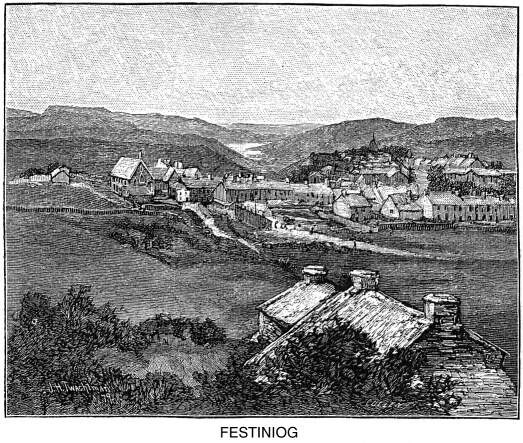
We came down to find the Christmas preparations advancing apace.
A curate and ladies were decorating a pretty parish church, passing
in and out under a gate-way covered with armorial bearings. A
festivity known as a "tea-eating" was announced from
one of the chapels. The band of the local volunteer rifle company
played "waits" in the evening in the principal quarters
of the town. The parlor of the inn was festooned with holly and
starred with oranges. The mistletoe, with its charming, waxen
white berries hung in the center, and the bar-maid wore a conscious
air. For Christmas day itself there was a local eisteddfodd,
or bardic contention. There are bards still, after the rights
and institutes of the bards of Britain, duly initiated in the
gorsedd, with its mystic circle of stones and drawn sword.
They are quiet little men, as I saw them in their shops, far
enough from the rhymers who stirred the blood of Llewellyn and
Owen Glendower. One William Roberts, styled Gwyllym Eryri, or
William of Snowdon, a sail-maker by trade and thrice the recipient
of the chief honors at the national eisteddfodds, was good
enough to furnish me with an original ode, or awdl, of his own,
on the Festiniog Railway. It is probable that the merit of these
compositions consists considerably in the versification, which
is of a difficult kind. The consonants in the first half of the
line must be repeated in the second, while the vowels are appropriately
varied.
"Thou art," says William of Snowdon, addressing the
Narrowest Narrow Gauge, "a monument to man's ingenuity. But
more wonderful than man's masterpieces are seen around us, the
towering mountains, the river and the valley. To the courteous
director, Spooner, also, deserved praise is hereby offered. Without
doubt be has been the occasion of great benefit to this our native
town."
Stories Page | Contents Page
|







